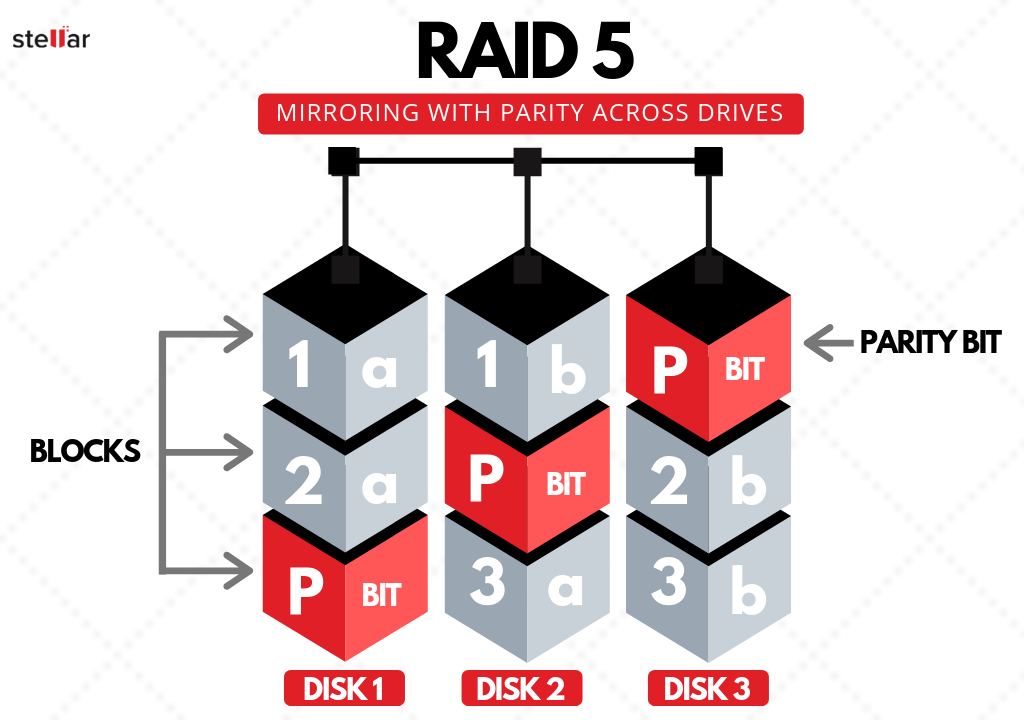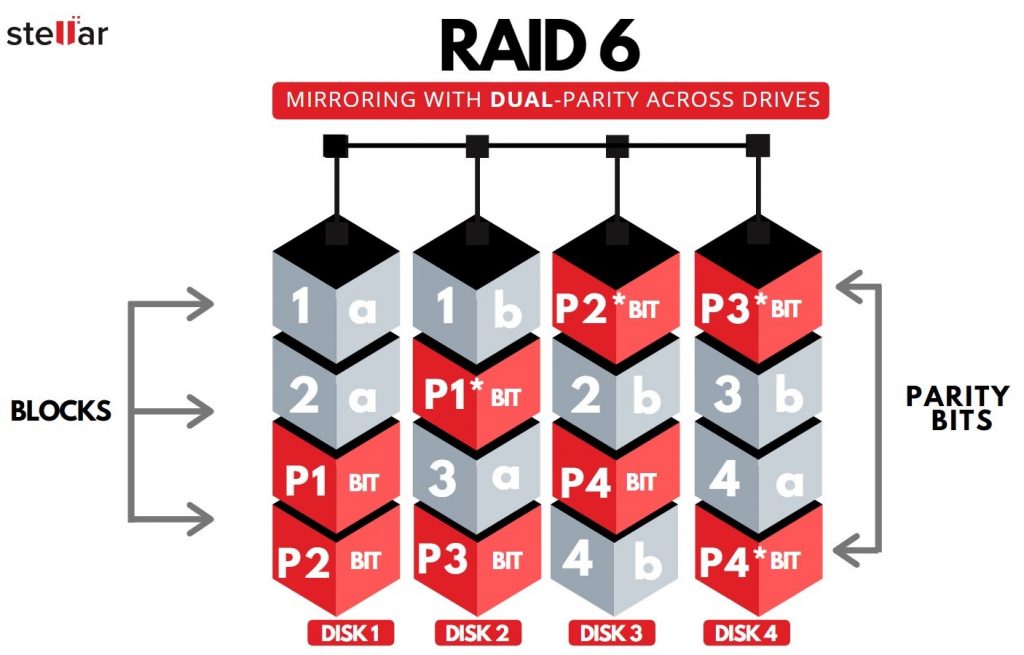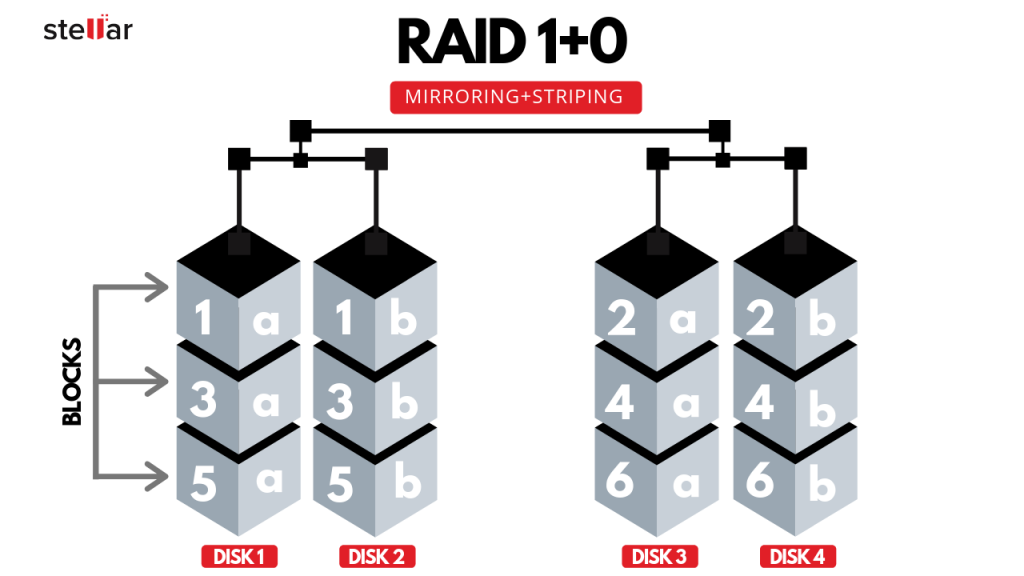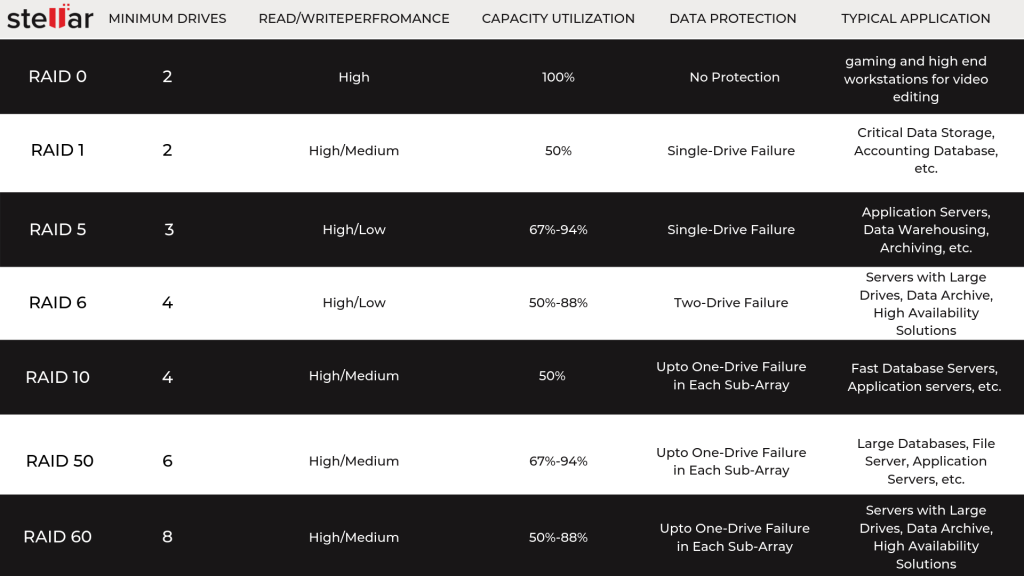Redundant Array of Independent Disks (RAID) is an advanced data
storage virtualization technology, which is widely used by gamers, developers, video
editors, professionals, and businesses around the world. That’s because RAID offers many advantages—such as
data redundancy, higher read/write speeds, or both—over the traditional hard
drive storage.
One can choose from different RAID levels starting with RAID 0 to RAID 10, which is a nested RAID arrangement of RAID 1 and RAID 0. Similarly, one can also create RAID 50, RAID 60, or RAID 100 as per their data storage requirements. However, nested RAID levels are expensive, and most users can’t afford it.
Which One Should You Choose and Why?
To help you decide which RAID level is right for your data
storage needs and, most importantly, budget, we have detailed everything about
various RAID levels—from RAID 0 to RAID 60—and mentioned their advantages, drawbacks,
and applications.
RAID Levels—A Detailed Comparison
Below is a detailed comparison of standard RAID levels such as RAID 0, RAID 1, RAID 5, RAID 6 and nested RAID levels—RAID 10, RAID 50, RAID 60. A comparison chart is also attached at the end of the post, comparing various RAID levels on parameters such as minimum drives requirement, read/write performance, storage availability, redundancy, and application.
| Important Tip: RAID array is not a backup solution. Never depend completely on a RAID level for your data. Always keep a regular backup copy of your data on an external drive or cloud storage as RAID arrays are highly susceptible to failure, corruption, and damage due to various logical errors caused by virus or malware infection, power failure or surge, bad sectors on RAID drives, SMART errors, etc. |
RAID 0
If you are into gaming and video editing, RAID 0 is the right configuration for your data storage needs. RAID 0 is a standard RAID configuration, which uses data striping in RAID to store data on the disk array. It’s the most affordable RAID configuration that requires at least two disks.
Demanding tasks such as gaming and video editing requires
frequent data transfer, often in large volumes. RAID 0 increases the read and
writes performance of your system by up to 2X than the normal hard drive and
spreads the load across drives.
Figure 1: RAID 0 Illustration- Striping Storage method is used for data storage
Pros
- High read/write performance, comparable to SATA SSDs
- 100% Disk volume available for use
- Affordable and easy to implement
Cons
- No fault-tolerance (redundancy)
Applications
- For storing and accessing non-critical data
- Gaming
- Video and Image Editing
Recovery Management
- If a drive fails in a RAID 0 level, data will be
permanently lost as RAID 0 does not offer redundancy. However, you can recover
a logically failed or broken RAID 0 level with the help of a RAID recovery software such as Stellar Data Recovery Technician.
RAID 1
RAID 1 uses mirroring method to for data storage and
requires at least two drives. It’s the most basic RAID level that provides
redundancy, i.e., protection against data loss due to disk failure. The data
copied to RAID 1 is stored in both drives as individual copies. Thus, if one
disk fails, you will be able to recover data from another drive.
Figure 2: RAID 1 Illustration- Mirroring Storage method is used for data storage
Due
to mirroring, RAID 1 storage is halved, i.e., you can use 50% of total disk volume with normal read/write speeds. However, unlike
RAID 0, RAID 1 can withstand up to 1 disk failure in each array without causing
data loss.
Pros
- Offers read/write speeds equivalent to SATA III hard
drive
- Fault-tolerant—can withstand up to 1 drive
failure
- No overhead as data needs to be copied to a replacement
drive, not rebuild
- Affordable and easy to implement
Cons
- 50% Storage space is available for usage
- Hot swap is a problem in many software-based
RAID 1 array
Applications
- For storing critical data such as accounting
files
- For small servers
Recovery Management
- RAID 1 can rebuild itself as quick as 30 minutes
to an hour as data is copied—not rebuild—from surviving drive to the new drive.
RAID 5
RAID 5 is expensive and often used by professionals and
businesses. Unlike RAID 0 and RAID 1, RAID 5 requires a dedicated hardware
controller with minimum 3 storage drives and supports maximum 16 disks. It uses
striping and parity bit data storage method to store your files across the disk
array.
It provides high read and write speeds along with redundancy
due to parity bits. Parity bits are the checksum of all data stored in all
drives of RAID 5 array.
A user can utilize up to 94% of the total combined disk
volume.
The parity bit helps restore data lost due to failure of up
to 1 disk in the array.

Figure 3: RAID 5- Mirroring With Parity Across Drives
Pros
- Read data transactions are fast due to faster
read speed but write speed is a bit slower, yet decent, due to parity bit
calculation
- Fault-tolerant—can withstand up to any 1 drive
failure in the array
- Up to 94%, combined disk volume is available for
use
Cons
- Overhead on all drive after disk failure and
RAID rebuild
- RAID rebuild after disk failure can take several
hours to a few days depending on the size of a failed disk
- Costly
Applications
- File and application servers
- Data warehousing
- Archiving
Recovery Management
- RAID 5 rebuild can take several hours and cause overhead,
which can lead to another drive failure during, rebuild process. So before
inserting new drive to RAID 5 array, check each disk’s SMART status by using a tool
such as Drive Monitor, CrystalDiskInfo, etc.
- Use Stellar
Data Recovery Technician to rebuild and recover data when RAID 5 gets
damaged due to corruption or other logical errors.
RAID 6
RAID 6 is a better version of RAID 5 and is often referred
as ‘RAID 5 on Steroids’. RAID 6
overcomes a major issue in the RAID 5, which is the inability to survive more
than 1 disk failure. RAID 6 can withstand up to 2-disk failure without data
loss.
RAID 6 also uses striping and parity bits to store data. However,
unlike RAID 5, RAID 6 stores parity bits in two disks and thus requires minimum
4 disk in the array. And thus, offers balanced read/write speeds with better
redundancy.
Due to two parity bits, RAID 6 allows you to utilize up to 88%
of the combined disk storage volume.

Figure 4: RAID 6- Mirroring with DUAL-Parity across drives
Pros
- Fast read data transactions
- Fault-tolerant—can withstand up to any 2 disk
failure from the array
- More secure than RAID 5
Cons
- Write data transactions are slower than RAID 5
due to dual-parity data
- Drive failure affects the entire RAID array
- Rebuilding RAID array can take a very long time
Applications
- High availability solutions
- Archiving
- Large critical databases
Recovery Management
- Instead of rebuilding RAID 6 directly after a disk failure, take out other drives from the RAID array and check the SMART status of the individual drive with Drive Monitor utility to ensure disks are healthy enough to withstand the rebuild process. If SMART shows warning such as Reallocated Sector Count Warning, Pending Sector Count warning, etc. use Stellar Data Recovery Technician to rebuild RAID 5 and recover data—works if disk failure occurs due to logical errors
RAID 10
RAID 10 is the nested RAID configuration made from a
combination of RAID 1 and RAID 0. It’s a
mirrored RAID 0 level. It uses both data striping and data mirroring
storage methods in a nested environment. Thus, it offers both higher read/write
speeds and better data redundancy than RAID 5 and RAID 6.
It requires at least 4 disks, but the total storage is
halved due to mirroring. So if you are going to use 4 1TB drives, you will
essentially get 2TB usable storage. It can withstand up to 2 disk failure—one
from either side. However, if two disks from one side fail, data will be lost and can’t be recovered.

Figure 5: RAID 10- Combination of RAID 1 (Mirroring) and RAID 0 (Striping) array
Pros
- Faster rebuild time as there is no parity data
- Faster read and write speeds
- Fault-tolerant—can withstand up to 2 disk
failure from one side
Cons
- Only 50% of storage is available for use
- Most expensive RAID level compared to RAID 6
which can also withstand up to 2 disks failure
Applications
- Fast database servers
- Application servers
Recovery Management
- RAID 10 can rebuild quickly after a disk failure,
as data is copied from the surviving drives to the new drive — similar to RAID
0. Also, there are quite fewer chances of failing two drives simultaneously from
the same side. Thus, RAID 10 is self-sufficient in recovery.
- For recovery of corrupt and logically failed
RAID 10 array, reach out to a data recovery expert.
RAID 50 & RAID 60
RAID 50 and RAID 60 are also nested RAID configurations of ‘RAID
5+RAID 0’ and ‘RAID 6+RAID 0’. Thus, it offers features of both RAID 5 and 6
along with RAID 0’s high read/write speed performance.
RAID 50 requires minimum 6 and supports maximum 48 disks in
single or multiple mirrored arrays of RAID 5.
Similarly, RAID 60 requires at least 8 disk drives
configured as two mirrored RAID 6 arrays
These RAID
configurations are used for storing large databases, archives, backups, and as
application servers. These RAID configurations offer high availability and can
withstand up to 1 drive failure in each sub-array.

Figure 6: RAID Level comparison chart
You might be wondering where are RAID 2, RAID 3 and RAID 4.
Well, they are not used anymore. And out of all RAID arrays, RAID 0, RAID 1,
RAID 5 and RAID 6 are the most popular RAID levels used by various users ranging
from a home user to a professional and businesses.
Conclusion
While choosing a RAID level, consider your needs—do you want performance, redundancy, or both. RAID 0 and 1 are suitable for home and some power users. They are easy to set up and does not always require a hardware controller.
While RAID 5, RAID 6, and RAID 10 or beyond are suitable for
SMBs as they offer both—better read/write performance and redundancy. However,
choosing between these RAID levels will entirely depend on your budget and if
you want more performance or better redundancy.
Further, remember that relying completely on RAID can be fatal for your data. Use a RAID recovery software such as Stellar Data Recovery Technician to rebuild and recover data from a broken, damaged, corrupt, and failed RAID 0, 5 and 6 arrays in just a few clicks.
To prevent RAID from failing, use Drive Monitor, a utility that comes with Stellar Data Recovery Technician, to keep a check on RAID drive’s health status and replace the impending drive before it leads to RAID failure.
Was this article helpful?